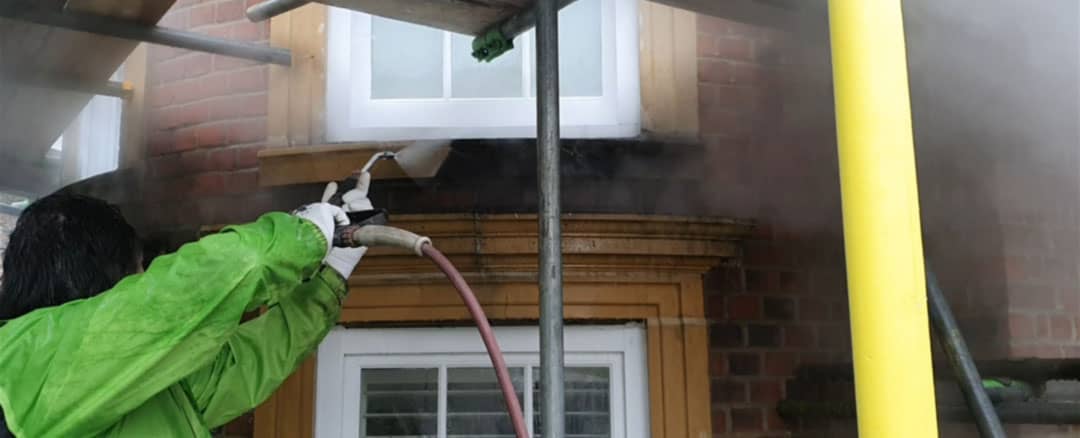Part One: Is Cleaning Required?
If you own or are responsible for the upkeep of historic stonework or stone buildings, then you will be aware of the importance of keeping the stone masonry in good condition.
But the first question should always be: does cleaning actually benefit the stonework in the long term?
In simple terms, masonry cleaning is likely to have short and possible long-term implications, some of which may be desirable and some unforeseen. Therefore, in order to make it as ‘safe’ as possible, we should concentrate on: minimising risk, managing expectations and paying close attention to the factors within our control.
Reasons for Cleaning
In general, the primary motives for cleaning are aesthetic and hygienic. For buildings, particularly historic structures, we might have additional or alternative objectives. The following are the principal ‘technical’ reasons for cleaning:
-
Reveal defects and facilitate a condition survey
-
Enable repair, repointing or redecoration
-
Preparation for additional treatments
-
Remove toxic residue or coatings
-
Improve legibility and facilitate recording
The following are broadly ‘aesthetic’ or commercial aims:
-
Engender social well-being, pride or respect
-
Remove disfigurements caused by a traumatic event
-
Fulfil the requirements of a lease
-
To evidence project expenditure
-
Increase commercial value
The presence of significant dirt is normally regarded as a sign of neglect. Even so, the cleaning of a listed building for aesthetic appearance is generally given a low priority by those providing consent. Quite rightly, we will be asked to justify the need, the method used and the degree of cleaning. The reasons for this include the perceived risk of physical damage and potential loss of historical patina. It is likely that any cleaning, however gentle, will result in some surface loss even if not readily visible to the eye. Nonetheless, thoughtful cleaning will mitigate the effect of soiling decay mechanisms and promote re-use of a neglected building. The balance of risks and benefits must therefore be considered for the long term (decades), not just before and after cleaning.
It is usually much more important to achieve an even result rather than the brightest clean. An effective way of reducing ‘risk’ is to limit the anticipated degree of cleaning or paint removal. It could be said that 90% of the risk is in removing the last 10% of the soiling or coating – highly unscientific but the principle is sound.
Part Two: Pre-Cleaning Investigation and Cleaning Trials
Before you embark on any treatment regime, If the structure is listed you should first be aware of the legal implications of listed building status. You must apply for listed building consent before undertaking any treatment to either, the exterior or the interior of a listed structure.
The next step is to determine what outcome is desired from a programme of treatment. Once you have a clearly stated goal, it will be easier to focus your attention productively on the best and most efficient means of realising that goal.
Identifying the types and extent of the external coating, soiling or other forms of deposition on the stone substrate is the next step. We recommend beginning with a visual examination, preferably facilitated by a high-quality magnifying lens or microscope.
Pre-contract trials should be undertaken at the earliest opportunity, well before the main works and in discreet locations representative of the substrate, soiling and detail. The aim is to demonstrate the suitability (or not) of each method and to determine the speed and cost.
It is preferable to select a trial panel that is located in a discreet position so that its use in the trial does not significantly affect the appearance of the building to passing onlookers. A small sample can be removed from the trial panel for off-site testing and analysis to distinguish the components of the coating. An ideal treatment regime will remove noxious and disfiguring extraneous deposits while leaving any harmless natural patina intact. In any case, it is important to find a treatment that will not cause any unnecessary harm the underlying substrate.
Part Three: Cleaning Methods
The British Standard BS 8221-1:2012 is a code of practice for the cleaning and surface repair of buildings and covers not only stone but also other common materials such as brick, concrete and even terracotta. There is a fee of a couple of hundred pounds for downloading the British Standard, but it will be found to be useful reading for anyone in unfamiliar territory, although it is not by itself enough to produce a specification for treating a particular stone structure. BS8221 sets out the different types of available treatment methods, which include; hand-powered mechanical methods, machine-powered mechanical methods, water-based methods, chemical methods, and laser or radiation-based methods.
In reality there is considerable overlap between the categories since chemical treatments routinely use water as do certain of the abrasive methods. Therefore, the category of each method is determined by which contributes the most to each mechanism.

1. Mechanical Stone Cleaning Methods
These include:
The one we are going to focus on is the abrasive method. Various materials and common chemicals can be used to mechanically remove deposits from stone masonry. These materials are collectively referred to as abrasives, and their application to mechanical cleaning as abrasive cleaning methods.
Each abrasive has a numerically rated mineral hardness property that helps to indicate its suitable applications. This ranges from the least hard such as talc (1 Moh) to the hardest such as aluminium oxide or corundum (9 Mohs).
Substrates tend to vary in hardness more than abrasives do, hence the importance of careful testing to ensure that the cleaning undertaken does not cause damage. For example, the different constituent minerals of a typical granite may vary in hardness from 3 Mohs (mica) to 7 (quartz), while the different constituent minerals of some types of sandstone may vary from as little as 2.5 Mohs (calcium carbonate) to 7 (silca / quartz).
The general rule is for the abrasive used to be slightly softer than the softest component of the substrate to ensure that it does not cause significant damage to the substrate. Where glass substrates are involved, the abrasive should be at least two Mohs softer, but this is not relevant to stone cleaning.
Abrasives may be applied by suspension in a managed flow of water, or carried by a managed current of air, or directly pasted on an adhesive strip. There are other methods too, and they all have their own ideal scenarios for use. For more details, see Jamie Fairchild’s paper ‘Abrasive Cleaning Methods for Masonry’.

2. Water-based Stone Cleaning Methods
These include:
Water Based Methods
-
Cold pressure water
-
Hot pressure washer
-
Superheated Water system
While cold water such as heavy rainfall tends to remove only the most readily absorbent forms of recently accumulated superficial dirt from masonry, when it comes to removing deep staining and stubborn accretions, much more powerful results can be achieved by heating water up to in excess of boiling point.
Under controlled high-pressure conditions, water, which normally boils at 100 degrees Celsius, can remain in liquid form up to a theoretical maximum temperature of 374°C. Water heated under pressure to above normal boiling point is known as superheated water.
In practice, the theoretical maximum of 374°C could only be approached at extreme and hazardous pressures requiring exceptionally heavy-duty engineering in a carefully controlled environment, so it is not realistic for on-site cleaning methods using portable machinery.
However, the advanced engineering of dedicated masonry-cleaning equipment such as ThermaTech® by Restorative Techniques allows for controllable pressures to heat jets of water to up to 150°C. Want to know more about the ThermaTech® download the brochure by clicking on the link.
At these temperatures, water is effective not only at cleaning organic growth, detritus and stains from stone and other substrates, but also at removing deliberate coatings such as paint, without damaging the underlying substrate.
When water-based cleaning methods are used on indoor masonry features, there can be an understandable concern of damage being caused to timbers, ceiling plaster or other sensitive elements of the building. This risk can be offset by using a suction-based recovery system to quickly remove the water vapour from the air together with any debris it has absorbed after the water strikes its desired target. ThermaTech® can be supplied with a recovery system called ThermaVac to this end.

3. Chemical-based Stone Cleaning Methods
These include:
-
Acid, alkali, detergent, algaecide, chelating agent, enzyme or other active chemistry
-
Aqueous or organic solvent composition
-
Liquid, gel, latex or poultice consistency
The use of chemicals can assist in the removal of particular types of debris from substrates by reacting with their natural chemical constituents.
Depending on the substrate and the type of accretion that needs to be removed, chemicals may be used in conjunction with water-based or mechanical removal methods.
Restorative Techniques have the experience and expert knowledge to advise on the specification of appropriate chemical-based cleaning solutions for all manner of masonry accretions and stains including carbon sulphation, plasticised masonry and emulsion paints, polyurethane and oil-based gloss paints, alkyd-based masonry paints, resinous paints, cement-based paint, graffiti, copper salts, calcified lime, gypsum crusts and films, browning, iron oxidation, and silicone leaching. All of our products can be viewed here.

4. Laser and Radiation-based Stone Cleaning Methods
Laser cleaning was first introduced in the 1960s, when Maiman built the first optical laser; Schawlow proposed the 'Laser eraser'. The first significant cleaning using this technology was achieved in 1972, when Asmus demonstrated the selective divestment of black sulphation from fragile stone in Venice, at the suggestion of conservators Lorenzo Lazzarini & Giulia Musumeci. The NdYAG laser, which is still the most common type of laser used in conservation cleaning, was used to clean a marble relief depicting 'the Last Supper' as part of conservation of the Porta della Carta of Palazzo Ducale, Venice, in 1980.
Since the 1990s, there has been a lot of research and development of laser radiation-based stone cleaning methods, essentially using photons (the fundamental particles that convey light) to target soiling at a level of energy density (the technical term is ‘fluence’) that does not damage the underlying substrate. It’s been over 50 years since their first use and the technology is advancing all the time with 5-500w portable lasers now available.
How it works is that the soiling absorbs energy from the laser beam, causing it to heat up and consequently to expand suddenly, with the result that it loosens and detaches from the substrate.
Laser treatment is sometimes combined with water for enhanced results, as the water rapidly heats up and turns to steam in explosive vaporisation, thus helping to remove the soiling from the surface.
The laser systems, much like the other methods mentioned in this article will not do everything on their own but should be considered as another tool in the toolbox and will no doubt give results where other methods can’t.
